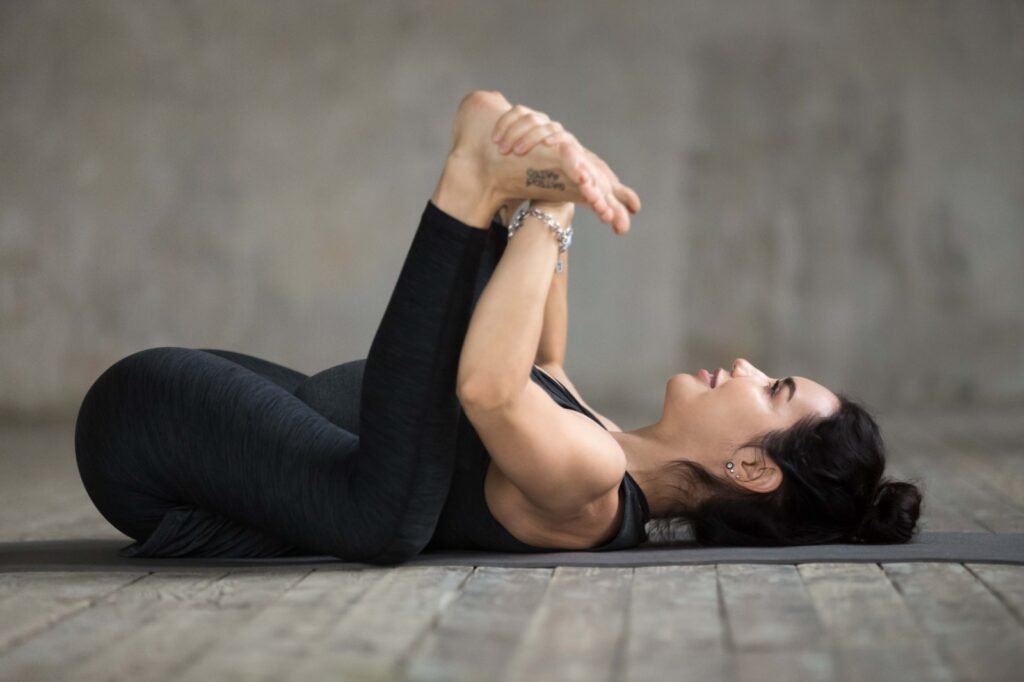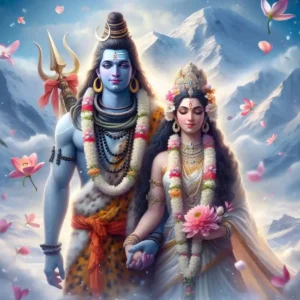Table of Contents
ToggleYoga is refined with plenty of valid Yogasanas. Every Asanas restrain our body and soul from over-tension and distractions. Here comes an effect Pose Named ‘ Ananda Balasana’ (Happy Baby Pose) defined as the gentle yet effective Yoga posture that stretches, enhances, and relaxes various areas of your body. Let’s get into the topic.
Ananda Balasana Meaning
Ananda Balasana is a name derived and originated from a Sanskrit word. The complete word is defined as follows:
1. Ananda
The word Ananda defines the meaning “Happy”. Happiness is the ultimate aim in involving anything.
2. Bal
Usually, Bal in Hindi defines the child. Here also in Sanskrit Bal refers to “Child”
3. Asana
Asana in Yoga describes the Pose or Posture while practicing Yoga. It involves in giving the physical wellness and also mental Well-being.
This stance is modelled after how babies naturally lie on their backs, gripping their feet with their hands, grinning, and occasionally rolling softly back and forth. As we age and get bogged down in life’s intricacies, it’s common to lose sight of the carefree delight and relaxation that this stance embodies. By imitating this childlike posture, practitioners can reconnect with that sense of innate happiness and simplicity. And also the benefits in many ways which leads us to enhance our Well-being.
Ananda Balasana ( Happy Baby Pose ) Yoga Benefits
Ananda Balasana shows out the prettiest form of Yogasana, as in the meaning of the name itself that is Happy Baby Pose describes the beauty of Pose which is compared to Babies. It also benefits more. Let’s look out them :
Benefits of Ananda Balasana ( Happy Baby Pose)
Hip Opener: (Stretching the hips and inner thighs):
This posture gives the hips and inner thighs, which are frequently stiff after extended sitting or physical activity, a deep stretch. Ananda Balasana helps improve range of motion and flexibility by opening the hips, which can help reduce the risk of injury during other physical exercises.
Lower Back Relief (Relief for the lower back):
The lower back in particular benefits from the relaxation and decompression of the spine caused by the mild pressure applied when pulling downward while holding the feet. This can be especially helpful for people who have lower back pain from sitting for extended periods of time or from tight hip flexors.
Stress Reduction (Providing calm and Stress Relief situation to body and soul) :
The peaceful quality of the position encourages unwinding and relieving tension. The parasympathetic nervous system is triggered while you concentrate on your breathing and the light rolling action, which lowers the body’s stress response and fosters a feeling of dispassion.
Encourages Mindfulness:
Ananda Balasana invites you to pay attention to your body and breathing in the here and now. This practice of mindfulness can foster inner contentment and serenity that transcends the yoga mat into daily life
Improves Blood Circulation:
Ananda Balasana serves to enhance circulation by raising the feet over the heart, particularly in the lower regions. This can be especially helpful for people whose legs swell or have poor circulation.
Stimulating the digestive system :
Ananda Balasana also Benefits in providing the complete digestion routine in our body. This creates a healthy atmosphere in our body and proper and efficient working and strength can be attained.
The way and Method for doing Anandha Balasana
Ananda Balasana, or Happy Baby Pose, is a simple yet effective yoga pose that provides and promotes relaxation. Here’s how to perform Ananda Balasana step by step:
How to perform Ananda Balasana:
1. Start in a probe Position
Begin by lying flat on your back in Savasana (Corpse Pose). Relax your entire body, and take a few deep breaths to settle in.
2. Bend Your Knees
On an inhale, bend your knees and bring them toward your chest. Keep your feet flexed, and position your knees wider than your trunk.
3. Grab Your Feet
Reach your hands up and grab the outer edges of your feet. Your arms should be inside your knees, and your elbows should be bent. If it’s difficult to reach your feet, you can hold your ankles or shins instead.
4. Align Your Body
To ensure that your shins are perpendicular to the floor, make sure your ankles are stacked exactly above your knees. The soles of your feet should be pointed upward when you are flexed. Press your tailbone and lower back firmly into the mat. Avoid letting your lower back arch away from the floor. If this happens, adjust your grip or use a yoga strap around your feet for support.
5. Deepen the Pose Gently pull down
Draw your feet down slowly with each exhalation to increase the stretch in your inner thighs and hips. To keep your spine neutral, continue to press your tailbone into the mat at the same moment. For five to ten deep breaths, hold the pose, paying attention to the stretch and the relationship between your breath and movement.
6. Have some Movements
If it feels comfortable, you can gently rock from side to side, massaging your lower back against the mat. This adds a playful element to the pose and can help release additional tension.
7. End up the Pose slowly
To release then exhale, and let go of your feet. Straighten your legs back onto the mat and return to Shavasana, allowing your body to rest and absorb the effects of the stretch
Tips for Ananda Balasana ( Happy Baby Pose)
•Use properties if needed, Use a yoga strap around your arches or hold onto your ankles or shins.
•Focus on keeping your lower back pressed against the mat. If you feel strain in your lower back or hips, back off slightly or use a bolster under your sacrum for support.
•Pay attention to your breath and avoid forcing the stretch. The goal is to find a balance between effort and ease.
Common Variations of Ananda Balasana ( Happy Baby Pose)
In Ananda Balasana (Happy Baby Pose), there are several variations that practitioners can explore depending on their flexibility, strength, and specific goals.
1.Supta Padangusthasana Variation (Reclining Big Toe Pose)
Steps:
- Lie on your back with your legs extended.
- Bend your right knee and bring close towards your chest.
- Hold the big toe of your right foot with your right hand, keeping the knee bent.
- Slowly straighten your right leg, extending it upwards while holding the toe.
- Keep your left leg extended on the ground.
- Hold the pose for a few breaths, then change sides.
2.Supta Ananda Balasana (Reclining Happy Baby Pose)
Steps:
- Lie on your back with your knees bent, and feet on the floor.
- Lift both legs towards the ceiling, bending your knees at a 90-degree angle.
- Reach for the outer edges of your feet with your hands.
- Gently press your knees towards your armpits while keeping your feet flexed.
- Engage your core and keep your lower back grounded on the mat.
- Hold the pose for 5–10 breaths, maintaining a relaxed and steady breathing pattern.
3.Eka Pada Ananda Balasana (One-Legged Happy Baby Pose)
Steps:
- Begin in Ananda Balasana, holding both feet.
- Release the grip on your right foot and extend the leg straight out in front of you, keeping the left leg in the Happy Baby position.
- Hold the outer edge of your left foot with your left hand, pressing the left knee towards your armpit.
- Keep the extended right leg active and grounded.
- Hold the pose for a some breaths, then change sides.
4.Baddha Konasana in Supta Ananda Balasana (Bound Angle Pose in Happy Baby Pose)
Steps:
- Start in Supta Ananda Balasana.
- Release your feet and bring the soles of your feet together, allowing your knees to open wide to the sides.
- Hold your ankles or the outer edges of your feet.
- Gently press your feet together while drawing your knees down towards the ground.
- Engage your core to keep your lower back grounded.
- Hold the pose for several breaths, feeling a deep stretch in your hips and inner thighs.
5.Twisting Ananda Balasana (Twisted Happy Baby Pose)
Steps:
- Begin in Ananda Balasana, holding both feet with your hands.
- Keep holding the right foot with your right hand and release the left foot.
- Bring your left arm out to the side for support, and gently guide your right foot across your body towards the left side, allowing your right knee to bend.
- Keep your left leg extended and stranded on the floor.
- Hold the pose for a few seconds with breathe, then return to the center and switch sides.
Deep Overview
Ananda Balasana comprises Classical Yoga and its Benefits in manifesting with our body and soul. Ananda Balasana, commonly known as Happy Baby Pose, is a relaxing and playful yoga posture often included in the closing sequences of a yoga practice. This pose resembles the position of a happy baby lying on its back and playing with its feet, which is where it gets its name. There also come variants of other Yogasanas like Sarvangasana( Shoulder stand), Shavasana (Corpse Pose), Trikonasana( Triangle Pose), and immense.
Hidden Mantra is a space that involves providing quality content and information about Classical Yoga practices. Here the Hidden Mantra blog opens a third-eye view for your doubts and queries related to Yoga. Keep updated with new things and Evolve a healthy and peaceful life, Namaste!









